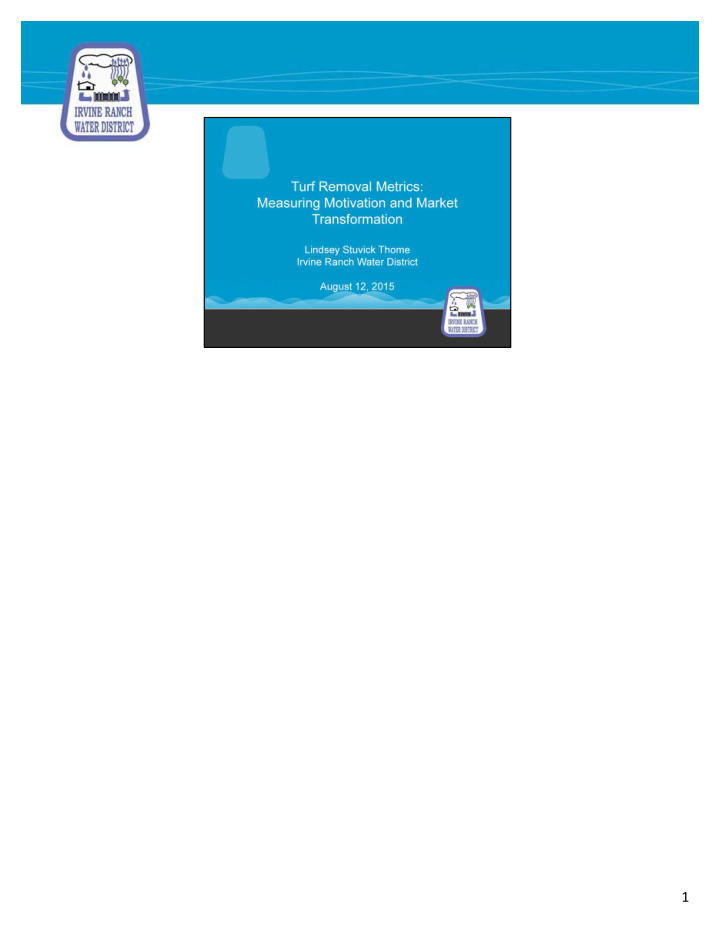



1
2
3
4
•Group 2 may include those who dropped out of the program or deemed ineligible because they completed the project prior to applying to the program 5
•Reduce risk to consumers by reducing the purchase price of a product, which decreases the risk to a consumer trying an unfamiliar product •Homes are primary financial asset and significant portion of personal debt •Innovative landscapes types might present a risk to an individual’s financial investment and overall wealth •Front yard o Inherently public •“What is open to be seen is also judged” – social pressure to conform, reinforcement •“powerful connective tissue…and inherently democratic medium” (AJ Downing) •“Wildness” or “messiness” of native landscaping •Maintained landscape indicates presence of caretakers and “cues to care”, sense of order, “the virtues of labor”, “respect for neighbors” •Descriptive norms: entail typical patterns of social activities or choices, aka ‘standard practice’ or THE LAWN •Injunctive norms: Involve judgment of un/desirability of specific actions. Ex) Neat, orderly, interpreted as neighborly 6
•FY11-12: GALLONS SAVED CALCULATED BY SUBTRACTING THE SUM OF EACH PARTICIPANT’S AVERAGE ANNUAL USE OF FISCAL YEARS 11-12, 12-13, & 13-14 FROM FISCAL YEARS 8-9, 9-10, & 10-11 •FY12-13: GALLONS SAVED CALCULATED BY SUBTRACTING THE SUM OF EACH PARTICIPANT’S AVERAGE ANNUAL USE OF FISCAL YEARS 12-13 AND 13- 14 FROM FISCAL YEARS 8-9, 9-10, 10-11, & 11-12; FYs 08- 09 AND 09-10 WAS INCLUDED IN THE PRE-ANALYSIS BECAUSE THEY WERE DRIER THAN FYs 10-11 AND 11-12 •OVERALL SAVINGS IS A WEIGHTED AVERAGE FROM FY11-12 AND FY12-13 7
•AVERAGE WATER SAVINGS ARE CALCULATED FOR EACH MONTH AND THE PRE AND POST PERIODS FOR RESPECTIVE YEAR ARE COMPARED 8
-Irvine benefits from its media market 9
-Irvine benefits from its media market 10
11
12
o Outreach materials and educational campaigns o Leverage partnership with WaterSmart •Reduce risk to consumers by reducing the purchase price of a product, which decreases the risk to a consumer trying an unfamiliar product •Homes are primary financial asset and significant portion of personal debt •Innovative landscapes types might present a risk to an individual’s financial investment and overall wealth •Front yard o Inherently public “What is open to be seen is also judged” – social pressure to conform, reinforcement “powerful connective tissue…and inherently democratic medium” (AJ Downing) •“Wildness” or “messiness” of native landscaping •Maintained landscape indicates presence of caretakers and “cues to care”, sense of order, “the virtues of labor”, “respect for neighbors” •Descriptive norms: entail typical patterns of social activities or choices, aka ‘standard practice’ or THE LAWN •Injunctive norms: Involve judgment of un/desirability of specific actions. Ex) Neat, orderly, interpreted as neighborly •An injunctive norm is based on what ought to be; or in simpler terms, an injunctive norm involves your perception of whether a behavior will be approved or disapproved by a given group. Injunctive norms are often referred to as moral norms because behavior is governed by the moral values of the individual. 13
•Appeal to Existing Values: Money, Time, Convenience, Functionality, Personal Aesthetic Preferences, Public Appearance/Social Reputation, Physical health, Environmental motivations •Promote New Values: •Environmental Stewardship, new aesthetic/sense of place, shared investment in community/social equity, patience 14
15
•Radio & Television cross market •Social Media – difficult market to tap into 16
•Irvine: 65% with bachelor’s degree or higher •$90,585 averagee annual household income •1992 median year home built 17
18
19
20
21
22
23
•Hypothesis: fundamentally different motivations •polynomial trendline 24
•Hypothesis: fundamentally different motivations •polynomial trendline 25
•Hypothesis: fundamentally different motivations •polynomial trendline 26
•Hypothesis: fundamentally different motivations •polynomial trendline 27
•polynomial trendline 28
•polynomial trendline 29
•“Compared to your neighborhood, do other neighborhoods have fewer, more, or about the same amount of drought- tolerant landscapes?” •No matter how they perceived their own neighborhood (a lot or a little), most felt that their neighborhood had the same amount as other neighborhoods. •Good application for geospatial analysis 30
•polynomial trendline 31
32
33
•DCSE will obtain the information regarding the turf removal program participants – address, date of turf removal, etc. (corresponding with the survey forms). DCSE will identify / map the locations of the turf program participants, and their neighbors in the 14 neighborhoods. This will facilitate planning the survey. 34
35
36
37
38
Recommend
More recommend